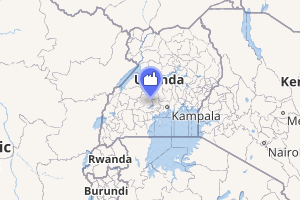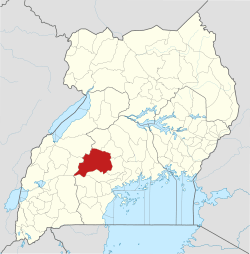Nkonge Solar Power Station
The Xsabo Nkonge Power Station (Xsabo Nkonge Solarline) is a USD 22 million 20 MW/AC solar power plant in Uganda that has been registered by the Electricity Regulatory Authority (ERA) in the national gazette for the implementation process. It is part of the USD 200 million planned investment of the Xsabo Group in Uganda for a total capacity of 150 megawatts.[1]
| Xsabo Nkonge Solarline | |
|---|---|

| |
| Country | Uganda |
| Location | Nkonge, Mubende District |
| Coordinates | 00°37′14″N 31°49′43″E |
| Status | Published in national gazette by Government |
| Commission date | 30 April 2021 (Expected) |
| Owner(s) | The Xsabo Group |
| Operator(s) | Xsabo Nkonge Solarline Limited |
| Solar farm | |
| Type | Flat-panel PV |
| Power generation | |
| Nameplate capacity | 20 MW (27,000 hp) |
When completed, Xsabo Nkonge Solarline is expected to be the largest grid-connected, privately-funded solar power plant not only in Uganda, but also in East and Central Africa, ahead of Soroti SPS (10 MW) and Tororo SPS (10 MW), and just a little bigger than The Xsabo Group‘s own Kabulasoke SPS with the same capacity of 20 MW, thanks to the Horizontal Tracking System that distinguishes Xsabo Nkonge Solarline from the solar project of the same brand in Kabulasoke.
Xsabo Lira Solarline (50MW), which is also part of the Xsabo Group, will become the largest solar power plant in Sub-Saharan Africa, outside of South Africa, when its anticipated commissioning takes place on 31 December 2021.[2]
Location
The power station is located in Nkonge Village, Bukuya Parish, in Mubende District, in Uganda's Buganda Region. The town of Bukuya, where the parish headquarters are located, is approximately 120 kilometres (75 mi) by road north-west of Kampala, the country's capital and largest city.[3]
Overview
The power station has a 20 megawatt capacity. Its output will be sold directly to the Uganda Electricity Transmission Company Limited for integration into the national grid. The power will be evacuated via a substation near the station.[4]
Developers
The power station is being developed by the company that owns it, which is Xsabo Nkonge Solarline Limited of the Xsabo Group, who successfully developed the 20 megawatt Kabulasoke Solar Power Station.
According to official public pronouncements by the Government of the Republic of Uganda, in particular the Electricity Regulatory Authority (ERA) and the Office of Uganda’s Vice President Edward Kiwanuka Ssekandi, as well as several interviews with Dr David Alobo, the owner and CEO/Managing Director of the Xsabo Group and the involved Local Governments of the Republic of Uganda, Xsabo plans to construct five solar power stations in different parts of Uganda with total capacity of 150 megawatts, at a budgeted cost of US$200 million.[1]
The five solar power stations are going to be developed in tandem, one after the other.[4]
Construction costs, funding, and commissioning
Construction is planned to be launched by Uganda’s Vice President Edward Kiwanuka Ssekandi, who is Patron of the 150MW Xsabo Solar Project of the Xsabo Group and also launched the Pilot Solar Project in Kabulasoke, in September 2020 and to be concluded in time for commissioning on 30 April 2021 ahead of the 50 megawatts Xsabo Lira Solarline, whose commissioning is scheduled for the period around 31 December 2021.[1]
References
- Businge, Julius (23 January 2019). "Xsabo Group to boost Uganda's electricity sector". The Independent (Uganda). Kampala. Retrieved 23 January 2019.
- Mwesigwa, Alon (21 January 2019). "Alobo wants all Ugandans on solar power in 10 years". The Observer (Uganda). Kampala. Retrieved 21 January 2019.
- Globefeed.com (21 January 2019). "Distance between Kampala Road Centre, City Centre, Kampala, UGA and Bukuya, Kassanda, Mubende, UGA". Globefeed.com. Retrieved 21 January 2019.
- Sadat Mbogo, and Misairi Thembo Kahungu (10 January 2019). "Solar power capacity to hit 50 MW". Daily Monitor. Kampala. Retrieved 23 January 2019.
External links
- Mega solar power project launched in Kabulasoke As of 9 January 2019.
